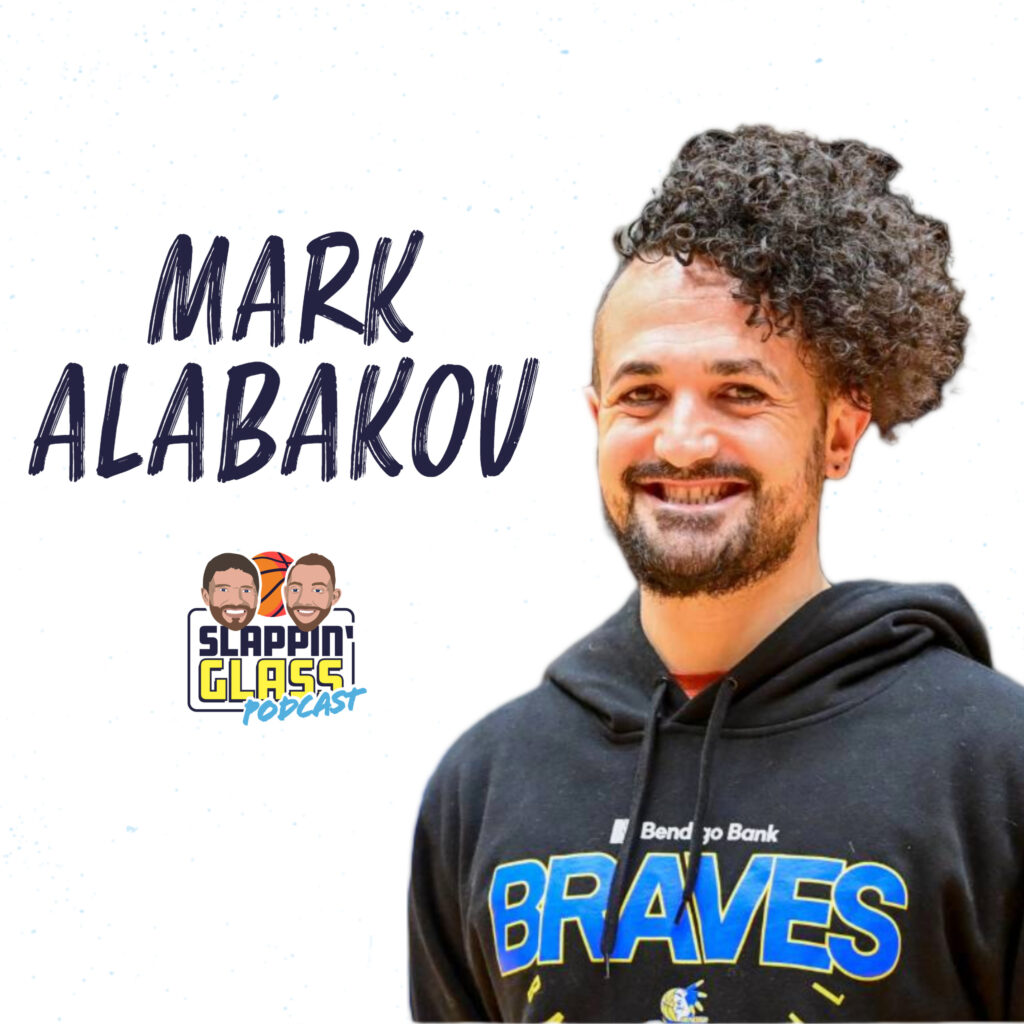
Slappin’ Glass sits down this week with Australian Professional Coach with over 12 years of experience on both the men and women’s side of the game, Mark Alabakov! The trio explore Coach Alabakov’s thoughts on running a Modern Shuffle Offense, finishing around the rim, and talk 2 for 1 situations and developing a coaching philosophy during the always fun “Start, Sub, or Sit?!”
Inside the Episode
*Note: Today’s full breakdown and deep-dive video of the Shuffle Offense (normally just for SG Plus members) is brought to you for free by Hoopsalytics! Check out the info below to receive 25% off an already affordable, terrific, and growing analytics platform!
In this week’s podcast with Australian Professional Coach, Mark Alabakov, we dive headfirst into a version of the Modern Shuffle Cut Offense, along the way discussing the philosophy behind running the offense, advantages of initiating with a rim cut, and the actions triggered off the initial entry passes. To shed more light on these topics, we collaborated with Coach Alabakov to put together this weekend’s breakdown showcasing the base actions of the offense. From these base actions, the Shuffle Cut Offense can be built out with different “exits” or specific calls to fit the specific strengths of a team.
Here’s a primer on some of the building blocks of the offense, followed by the full video…
Spacing
The Shuffle Cut Offense begins similar to the Princeton Offense’s “2-3 alignment” where all 5 players are spaced above the FT Line…
Zooming In: As we discuss in the podcast, the imminent threat of a rim cut is the catalyst for the offense to begin building its advantages. To maximize the threat of this cut, it’s important to elevate the wings and center off the baseline, freeing the rim from defenders.
The trailing guard, as shown above, will run near the rim line for two reasons:
- To be available for the ball reversal (more on that below), and
- To receive a flat screen when becoming a cutter.
As we have discussed before, a flat angle screen can be more effective in forcing “overs” and punishing defenders who attempt to shoot under the screen. Therefore, as the offense shuffles through their actions, there is always an emphasis on getting back to this initial setup in order to achieve the proper screening angles and keep maximum pressure on the rim.
The “2.5” Plays
As Coach Alabakov explains in the podcast, the base offense is comprised of “2.5 plays”, with two plays being triggered of the direction of the entry pass, and the half-play serving as a counter to the denial of a ball reversal.
Play #1 – Strongside Entry
The first set of flowing options begin with a strongside wing entry, triggering a quick UCLA screen…
…which flows into an Empty Corner PnR coupled with a weakside stagger screen for the PG after the cut…
After this action one can begin to tailor the offense to the strengths of their athletes. For example, Coach Alabakov likes to flow directly into a “cross-screen-down-screen” action for their center…
Zooming In: Shown above, the 2nd screener in the weakside stagger continues directly into a cross screen for the rolling center while the first screener spaces to the strongside corner.
Play #2 – Reversal Entry – “3rds”
If at this point you’re wondering “where’s the shuffle cut in this Shuffle Cut Offense”, here it is…The second option (play #2) is initiated when the ball is reversed through the trailing guard to the weakside wing. Coach Alabakov refers to this as their “3rds” play.
The ball reversal triggers the shuffle cut action, screening the PG to the rim while the center and trail set a stagger away…
The offense can continue to flow from shuffle cut to shuffle cut if the wing (2nd cutter) coming up off the double screen does not receive the ball…
Zooming In: If the 2nd cutter does not receive the ball, they will curl to the elbow with the 5 popping out to reverse the ball.
And from this action, once again, the offense can tailor their exits to the specific skills of the players, choosing to play from post automatics should the ball hit the shuffle cutter, or taking advantage of the specific strengths on the pass to the second cutter off the stagger…
Zooming In: Discussed and shown in today’s video, a catch by the 2nd cutter in this offense triggers a rim dive by the 5 with the other screener spacing to the wing/corner while a pind down screen takes place on the strongside.
Play #3 – 1/2 Play – Pistol Exit
Lastly, the “1/2 play” occurs anytime the ball reversal is denied. If this happens Coach Alabakov’s squad will flow into their “Reverse Pistol” action…
Zooming In: On the denial, the ballhandler will reverse the ball back to the strong side, triggering the split player to rim cut out, allowing the wing to lift up into the “DHO-to-Ballscreen” action. Lots of good stuff.
As Coach Alabakov shares in the podcast, this offense can allow coaches to find a happy balance between dictating actions when the time calls for it (“long” vs “short” offenses, side screen vs cross screen, etc.) or allowing players the freedom to find their own solutions and exits based upon the structure and automatics built in place.
To learn and view more on the Shuffle Cut Offense, plus how to run it against a zone defense, view the full breakdown now on SGTV!

As mentioned above, we were joined on the podcast this week by Australian Pro Coach, Mark Alabakov! With experience in the NBL and NBL1 on both the men and women’s side, along with working with some of the best coaches in Australia, Coach Alabakov is a wealth of information across the board. Beyond the deep breakdown of the Shuffle Cut Offense detailed above, we dive into other areas including:
- “2 for 1” and Special Situations: During “Start, Sub, or Sit?!” we explore some special situations with Coach Alabakov including “2 for 1” opportunities and the shots, sets, and philosophy behind them. Some nice insights here on how to avoid merely jacking up a 30 foot three during a “2 for 1” situation.
- Learning from Winning Coaches: As pointed out earlier, Coach Alabakov has worked for some of the great coaches in Australia and we had a great discussion about some of the major learnings from his years both observing and working alongside these great coaches.